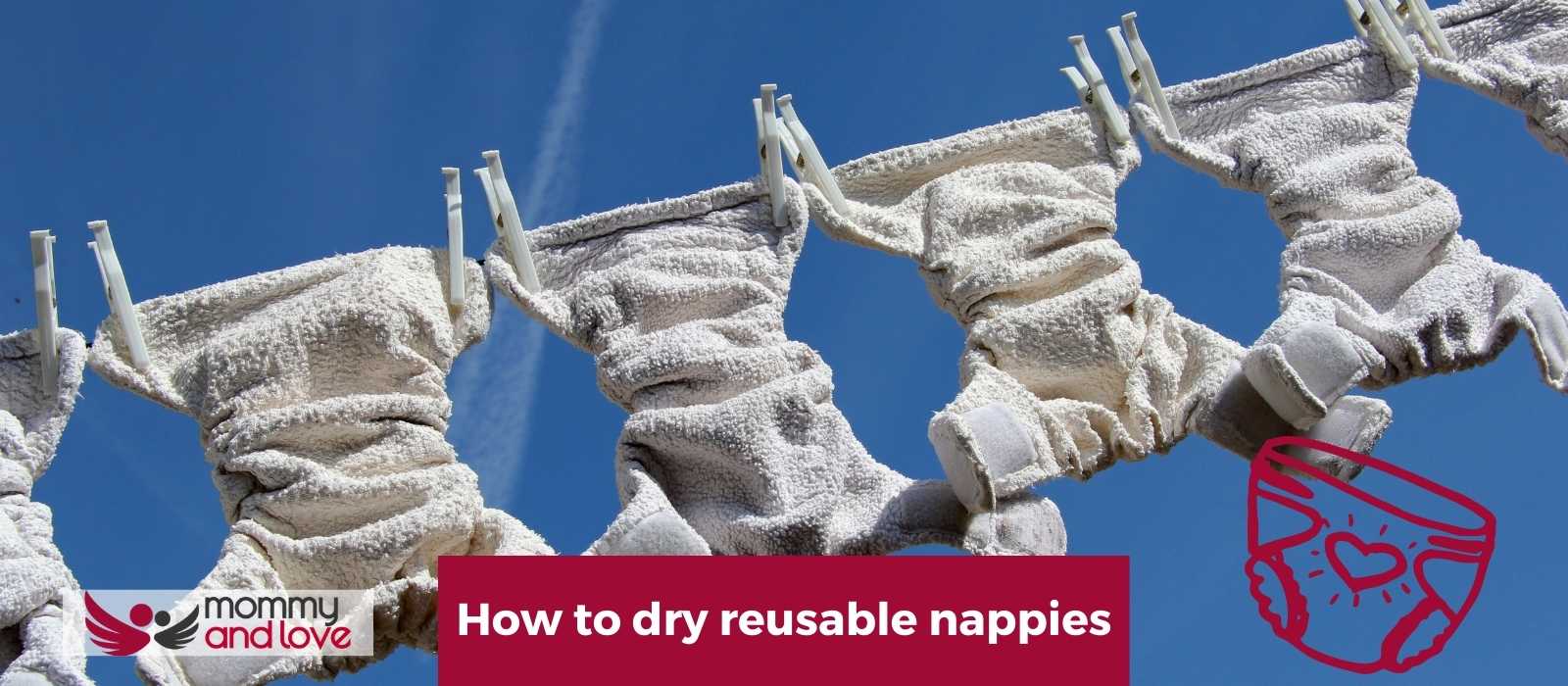So you’ve mastered washing nappies, now you need to know how to properly dry reusable nappies. Knowing what materials nappies are composed of and how to properly dry them will result in a more enjoyable nappy changing experience.
Material Choice – it matters when it comes to drying nappies!
Every nappy fabric has its pros and cons. Whilst microfibre is a super quick dryer, it’s not very absorbent but microfibre nappies still play their part. The converse is said for hemp, whilst it’s super absorbent, it’s a very slow drying fabric. Somewhere you need to find what works for you and your drying facilities, and usually, a mixture of everything is recommended.
Cloth nappies made of hemp and bamboo are extremely absorbent, however, they take longer to dry as a result of their high absorbency. A cotton diaper’s absorbency versus drying time is highly variable, and microfiber nappies are less absorbent than cotton nappies yet dry the quickest of all available materials. Parents can select which nappies to purchase based on their preferences for the materials used in the diapers.
Bamboo nappies cause most issues, especially if they are sewn in multiple layers.
Nappy Style Makes a Difference

Pocket nappies come into their own in wintertime.
Or indeed any nappy where the layers can be pulled apart to dry your nappies more quickly.
Most of the inserts and flat nappies can go in a tumble drier but even the length of time a tumble drier is needed is shortened dramatically by your choice of nappies.
How many nappies do you have?
Will also help you get through the winter sane! Obviously, the more baby’s nappies you have in your rotation the less stress there will be to tumble dry and get them dried. If budget allows, and you don’t have a tumble drier you need to invest in more nappies. We’ve included this in our how many nappies you need guide here.
What is the best way of drying nappies in the winter?
The summer has come to an end, and the cooler days have arrived, which can only mean one thing: cloth nappies are becoming increasingly difficult to dry!! This is the time of year when many cloth parents feel concerned, when they may begin to run out of cloth due to a shortage of drying space, and when the amount of cloth they have can become overwhelming. #
Can you put reusable nappies in the dryer?
The answer is yes, you can use a tumble dryer to dry your cloth diapers. Tumble drying your nappies on low heat saves the most time and is the most efficient method. The downside of this is that it will limit the lifespan of your nappies over time. If you reside in a hard water area, your nappies may feel very stiff after they have been line-dried; a quick 10-minute blast in the dryer may help to soften them even further.
We would avoid putting waterproof wraps in the tumble dryer, they really don’t need it and will dry very quickly on an airer or even over the back of a chair.
Putting your stiff cloth nappy for a 10-minute blast in the tumble dryer will also help keep them soft after line drying. If you live in a hard water area, as you can’t use fabric softener in our wash cycle, this is a great way to keep a reusable nappy lovely and soft. Once you take them in from the washing line, check for any which need softening and just blast them on low heat for 10 minutes or so. The friction and heat will help make them soft again.
Airers – You’re Best Friend for Cloth Nappies in Winter
When it comes to employing airers, make certain that the room is well ventilated. Microfibre nappies and wraps dry quickly with this method, but more absorbent fibers such as bamboo, thick cotton, and hemp will take a long time to dry using this technique. An airing cupboard is great if you have one but not everyone does so investing in Indoor Airers might really help you.

Having a suitable number of airers to accommodate both your nappies and your clothes is clearly a very vital consideration, but space can be a problem in some situations. As a result, there are many different types of airers available on the market today, and you should be able to simply discover one that will function nicely in your residence.
We all know that heat rises, thus the greatest way to increase drying time indoors is to stack those diapers, inserts, boosters, and wipes on a shelf at a high altitude to dry faster. Get yourself something fun to hang on the wall, that you can hang from the curtain rail or over the door. These are excellent space savers since they let air circulate over the entire nappy or insert. Another fantastic solution that I’ve come across is a Pulley Maid or 
It will help to speed up the drying process if you place your airer in front of an electric, gas, or open/log burner fire; however, make sure to move it every now and then to avoid any nappies from overheating.
Can you dry reusable nappies on a heated Airer?
Yes, you can use a heated airer to dry nappies if you have one. In addition, microfiber nappies can be placed immediately on the drying rack, which will help to speed up the drying process. It is recommended that you place a towel on the rails before placing a diaper consisting of bamboo fiber and waterproof PUL layers on the rails to prevent them from melting. But overall, Heated Airer’s offer a great chance to dry your nappies in winter!

Can I dry cloth nappies on a radiator?
Nappies should never be put on a direct heat source, especially if it is hot. This is more critical for some nappies compared to others. Knowing that heat and PUL are not compatible, it is important to use caution when employing heating systems at home. With a wipe, you can place it directly on the radiator, but if you are using a cloth diaper, it is more dangerous unless the temperature is kept at a very low setting. In lieu of this, invest in a radiator airer that can be hung on the top of your radiator to keep your cloth nappies at a safe distance from the heat.
It is also beneficial to place microfiber or bamboo nappies near, but not directly on, a heat source such as a radiator during the colder months, especially during the winter. Cotton material can be placed directly on a heat source, but anything incorporating PUL material should not be placed directly on a heat source, since it will melt the cotton.
What Spin Cycle in the Washing Machine for Washing Nappies?
There are two rinses you need to do in your washing routine with your reusable nappies. A pre-wash cycle, which can be any spin. The aim here isn’t necessarily to get the nappies spun dry, it’s to agitate the soiled nappies and remove ‘poo’. After your main wash cycle, your final spin speed should be as fast as your machine will allow it.
To provide a good comparison, a bamboo nappy will take approximately the same amount of time to dry as a pair of thick denim pants. The key to washing bamboo is to ensure that it always receives the fastest spin speed possible in the washing machine. The greater the amount of liquid removed from the fabric during the wash cycle, the faster the fabric will dry.
Washing Line
If it’s a cold but not wet day, a blast in the fresh air always helps real nappies. Not only will the sun help stains, just blasting air is always good for keeping nappies fresh, you can tackle moisture inside once they have had a good blast of air! Direct sunlight, whether from the outside or from within a room through a window, will naturally bleach the cloth and eliminate any persistent stains from it.
Tips
Boosters are your friend. Invest in more! Hemp inserts take a while to dry but if you just have more on hand this will help you get your nappies back into use more quickly, even if your boosters and inserts are still drying.
Look for nappy styles which come apart easily, the fewer layers sewn together the better for drying time. We love the flip organic day inserts as whilst they are organic cotton, they fold out to be a big very thin piece of material that dries very quickly.
Maintaining a consistent routine will assist you in staying on top of your real nappies washing. Take things at your own pace, and do what works best for you, your kid, and your way of life. Using reusable nappies just occasionally is acceptable – remember that using one reusable nappy instead of a disposable will prevent the waste of 912 single-use nappies from being produced.

This article was written by: Gian MIller – Full-Time Writer, Baby Whisperer & Dad of 3.
Gian spends a lot of his time writing. A self-proclaimed baby whisperer, Gian has been through it all with his own children and is passionate about sharing his hard-won wisdom with other parents. When he’s not writing or changing diapers, you can find him playing the guitar or watching baseball (or preferably both at the same time).




